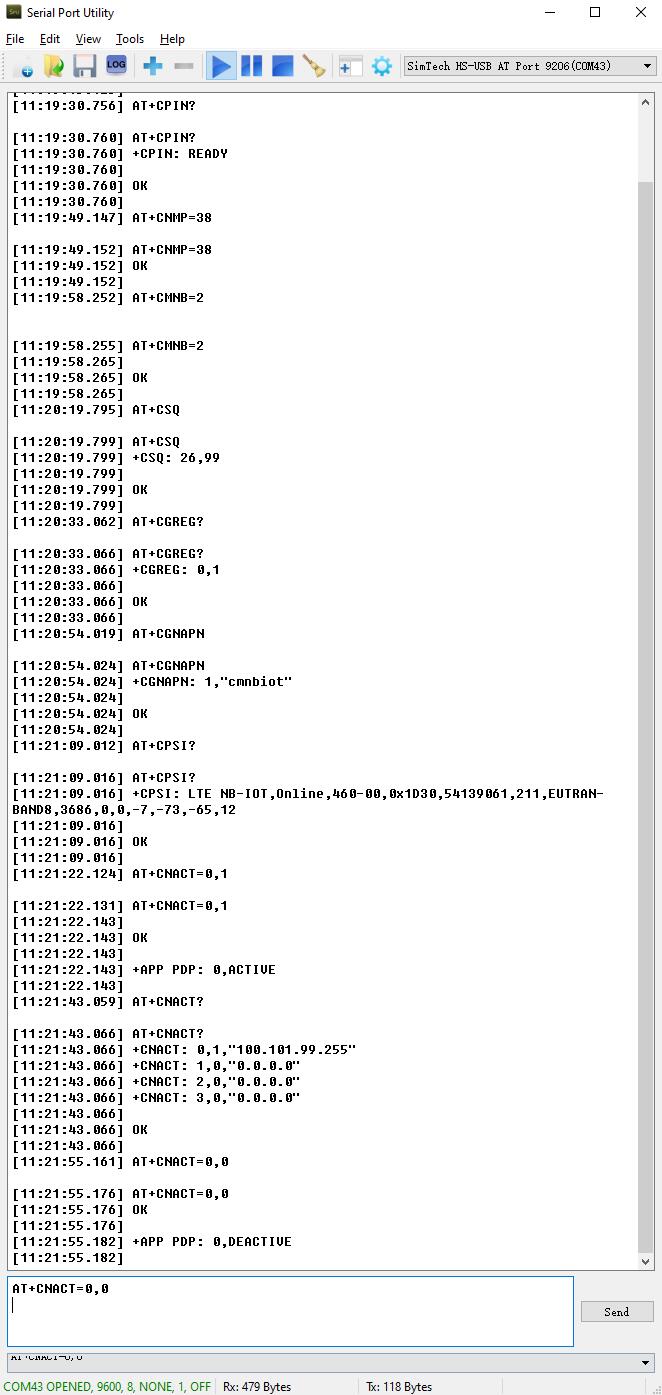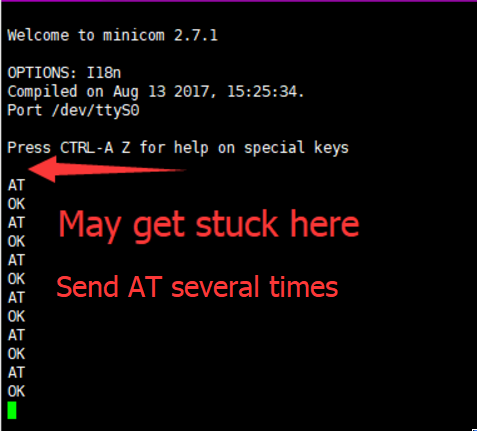SIM7070G Cat-M/NB-IoT/GPRS HAT
| ||
Overview
Introduction
SIM7070G NB-IoT / Cat-M / GPRS HAT For Raspberry Pi, Global Band Support, with GNSS Positioning.
| More |
Features
- Standard Raspberry Pi 40PIN GPIO extension header, supports Raspberry Pi series boards.
- Supports communication protocols such as TCP/UDP/HTTP/HTTPS/TLS/DTLS/PING/LWM2M/COAP/MQTT.
- Supports GNSS positioning (GPS, BeiDou, GLONASS, Galileo).
- Onboard USB interface, to test AT Commands, get GPS positioning data, and so on.
- Breakout UART control pins, to connect with host boards like Arduino/STM32.
- Onboard power conversion circuit, default is 3.3V operation, can be set to 5V via jumper resistor.
- SIM card slot, supports ONLY 1.8V SIM card (3V SIM card is not available).
- 2 x LED indicators, easy to monitor the working status.
- Baudrate: 300~3686400 bps.
- Common baud rate auto-negotiation: 9600/19200/38400/57600/115200 bps.
- Comes with online development resources and manual (examples for Raspberry Pi/Arduino/STM32).
Communication Parameters
- Support Bands:
- NB-IoT: B1/B2/B3/B4/B5/B8/B12/B13/B18/B19/B20/B25/B26/B28/B66/B71/B85
- Cat-M: B1/B2/B3/B4/B5/B8/B12/B13/B14/B18/B19/B20/B25/B26/B27/B28/B66/B85
- Transmission Power:
- Class 5(Typ.21dBm)
- Data Transmission:
- NB-IoT
- UL≤150kbps
- DL≤136kbps
- Cat-M
- UL≤1119kbps
- DL≤589kbps
- GPRS
- UL≤85.6kbps
- DL≤85.6kbps
- EDGE
- UL≤236.8kbps
- DL≤236.8kbps
- NB-IoT
GNSS Parameters
- Receiver type
- 16 channels
- C/A Code
- Working Frequency
- GNSS L1: 1575.42±1.023MHz
- GLONASS: 1598.0625 ~ 1605.375MHz
- BeiDou: 1559.052 ~ 1591.788MHz
- Galileo L1: 1575.42±1.023MHz
- Update Frequency: 1 Hz (Default)
- GNSS data format: NMEA-0183
- GNSS antenna: active antenna
Other Parameters
- Power supply: 5V
- Logic voltage: 5V/3.3V (switch via 0ohm resistor)
- Overall current (idle mode): about 41mA
- Operation temperature: -40°C ~ 85°C
- Storage temperature: -45°C ~ 90°C
- Dimensions: 30.5mm x 65mm
User Guide
Testing it in Windows PC
- 1. Hardware connection and driver installation
- Before testing, you should prepare
- A Micro USB cable
- LTE and GPS Antennas
- The SIM7070G Cat-M/NB-IoT/GPRS HAT
- An NB-IoT SIM card.
- Insert the SIM card into the SIM7070 board, and connect the LTE antenna and the GPS antenna. Connect the micro USB of the SIM7070G board to the PC by USB cable.
- Hold the PWRKEY button for about 1s to power on the module. After powering on, the STA indicator lights on, NET indicator quick-blinks first and then slow-blinks.
- Download the driver file, unzip it. Then update the driver by Devices Manager.
- USB has enumerated three devices. Choose AT Port COM31 as the communication serial port. Users can check the port number enumerated by the PC.
- Note: The SIM7080G supports global frequency bands, so there may be delays when registering on the network. Users in different countries and regions should consult local mobile service providers. About LTE-M or LTE-NB usage, or wait for the SIM7080G to automatically lock onto the local frequency band after registering on the network. You can use the command "AT+CPSI?" to query network information from the SIM7080G.
Test network
For more information about the AT commands, you can refer to SIM7080 Series AT Command Manual V1.02
| Command | Descriotion | Return |
|---|---|---|
| AT | Test command | OK |
| AT+CPIN? | Check SIM card | OK |
| AT+CNMP=38 | Choose LTE mode | OK |
| AT+CMNB=2 | Choose NB network | OK |
| AT+CSQ | Check signal intensity | OK |
| AT+CGREG? | Check netwok status | OK |
| AT+CGNAPN | Query APN | OK |
| AT+CPSI? | Request UE system information | OK |
| AT+CNACT=0,1 | activate application network | OK |
| AT+CNACT? | Check network IP | OK |
| AT+CNCAT=0,0 | Close application network | OK |
Test MQTT
For more information about the MQTT, please refer to SIM7070_SIM7080_SIM7090 Series_MQTT(S)_Application Note_V1.02
Please test Web by clicking here. Please check the TCP port and domain name when testing, for details, please refer to here
| Command | Description | Return |
| AT+SMCONF | Set MQTT | OK |
| AT+CSSLCFG | SSL configuration | OK |
| AT+SMSSL | Select SSL setting | OK |
| AT+SMCONN | MQTT connection | OK |
| AT+SMPUB | Send data packet | OK |
| AT+SMSUB | Subscribe to topics | OK |
| AT+SMUNSUB | unsubscribe | OK |
| AT+SMSTATE | Request MQTT connection status | OK |
| AT+SMPUBHEX | Set data format to hexadecimal | OK |
| AT+SMDISC | Disconnecting MQTT | OK |
HTTP(S) Test
The following table is the HTTP(S) test command, the test results are shown in the figure on the right, please refer to the detailed description of the SIM7070_SIM7080_SIM7090 Series_HTTP(S)_Application Note_V1.02
| Command | Description | Return |
|---|---|---|
| AT+SHCONF | Setting HTTPS(S) | OK |
| AT+SHSSL | Select SSL setting | OK |
| AT+SHBOD | Set Body | OK |
| AT+SHAHEAD | Add Head | OK |
| AT+SHPARA | Set HTTP(S) Para | OK |
| AT+SHCPARA | Clear HTTP(S) Para | OK |
| AT+SHCHEAD | Clear Head | OK |
| AT+SHSTATE | Query HTTP(S) connecting status | OK |
| AT+SHREQ | Set respond type | OK |
| AT+SHREAD | Read respond data | OK |
| AT+SHDISC | Disconnect HTTP(S) | OK |
Test TCP
For more information about the TCP, you can refer to SIM7070_SIM7080_SIM7090 Series_TCPUDP(S)_Application Note_V1.02
Note that to test TCP you need to map LAN IP and router first.
| Command | Description | Return |
|---|---|---|
| AT+CACID | Set TCP/UDP index | OK |
| AT+CASSLCFG | Set SSL parameters | OK |
| AT+CAOPEN | Open a TCP/UDP connection | OK |
| AT+CASEND | Send data | OK |
| AT+CARECV | Receive data | OK |
| AT+CACLOSE | Cose TCP/UDP connection | OK |
| AT+CACFG | Set transparent parameters | OK |
| AT+CASWITCH | Enable transparent mode | Ok |
Test GNSS
For more information, please refer to SIM7080 Series_GNSS_Application Note_V1.00
When testing GNSS, you should set the GPS antenna in the open area. You can also use u-center software for locating.
| Commands | Description | Return |
|---|---|---|
| AT+CGNSPWR | Open/close GNSS power | OK |
| AT+CGNSINF | GNSS information | OK |
| AT+CGNSCOLD | GNSS cold starting | OK |
| AT+CGNSWRAM | GNSS warm starting | OK |
| AT+CGNSHOT | GNSS hot starting | OK |
| AT+CGNSMOD | GNSS workign mode setting | OK |
| AT+CGNSXTRA | Open GNSS XTRA | OK |
| AT+CGNSCPY | Copyt GNSS XTRA file | OK |
| AT+SGNSCFG | GNSS NMEA output setting | OK |
| AT+SGNSCMD | AT port output GNSS NMEA data | OK |
Use it with Raspberry Pi
- Initialize IO and install software
The PWRKEY pin is connected to P7 (wiringPi number) of Raspberry Pi by jumper. To let the SIM7080G board work normally, you should firstly initialize the P7 pin. Download codes and run by the following commands.
sudo apt-get update sudo pip install RPi.GPIO sudo apt-get install python-serial wget -P ~/Documents/ https://files.waveshare.com/upload/4/4a/SIM7070G_Cat_M_NB_IoT_HAT_Code.tar.gz cd ~/Documents tar -xzf SIM7070G_Cat_M_NB_IoT_HAT_Code.tar.gz sh ~/Documents/SIM7080G_Cat_M_NB_IoT_HAT_Code/RaspberryPi/pi_gpio_init.sh
- Enable UART and hardware connection.
Open raspi-config by following commands, and choose Interfacing Options -> Serial, close login shell and open the hardware serial port.
sudo rapsi-config
The python codes is provided for MQTT function.
cd ~/Documents/SIM7080G_Cat_M_NB_IoT_HAT_Code/RaspberryPi/python/mqtt/ sudo python mqtt.py
Use it with STM32
The demo codes provided is based on Waveshare Open103C, it is use for TCP connecting.
Use it with Arduino
The demo codes provide is based on Arduino UNO. The D10 (RX) and D11 (TX) is used for software serial.
Resources
Document
Related Resources
Tools
SIM70X0 Related
Datasheets
- SIM7080 Series_AT Command Manual_V1.02
- SIM7070_SIM7080_SIM7090_Series_Email_Application_Note_V1.02
- SIM7070_SIM7080_SIM7090_Series_HTTP(S)_Application_Note_V1.02
- SIM7070_SIM7080_SIM7090_Series_MQTT(S)_Application_Note_V1.02
- SIM7070_SIM7080_SIM7090_Series_TCPUDP(S)_Application_Note_V1.03
- SIM82XX_SIM83XX Series_AT Command Manual_V1.02
- More...
FAQ
SIM7080X and SIM7070X series cannot connect to cellular networks and GPS positioning at the same time.
{{{5}}}
- Fixed NB-IOT or CAT-M Easier to get the signal:
AT+CMNB=2 //Fixed NB-IOT AT+CMNB=1 //Fixed CAT-M
- Fixed LTE mode can register to the network faster:
AT+CNMP=38
Please refer to the following manual for specific instructions: SIM7070_SIM7080_SIM7090_Series_AT_Command_Manual_V1.03
{{{5}}}
Support
Technical Support
If you need technical support or have any feedback/review, please click the Submit Now button to submit a ticket, Our support team will check and reply to you within 1 to 2 working days. Please be patient as we make every effort to help you to resolve the issue.
Working Time: 9 AM - 6 PM GMT+8 (Monday to Friday)
















